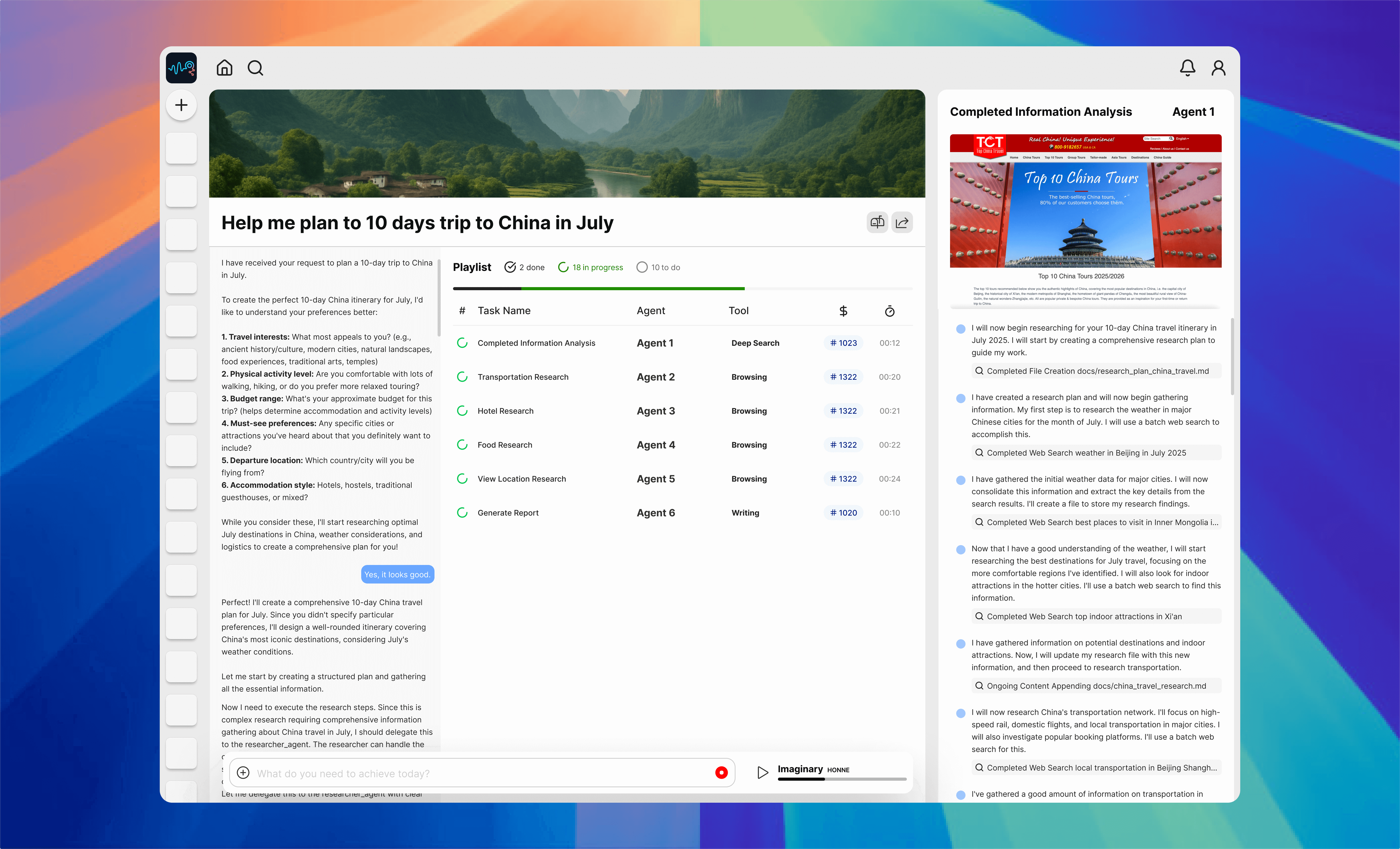🧐 Finding an Intuitive Vessel for AI Agents
Multi-agent systems, which involve multiple AI agents collaborating to solve complex problems, represent a significant technological frontier. However, a key challenge remains: How can we design an interface that allows everyday users to intuitively manage, curate, and deploy these systems in real-world scenarios?
Just as the chat interface unlocked the potential of Large Language Models (LLMs) and created a new paradigm for conversational AI, a similar breakthrough is needed for multi-agent systems. This project explores the development of such an interface.
😃 Inspiration: The Playlist as an Interaction Model
This experiment proposes and investigates the "playlist" as a primary interface for multi-agent systems. A playlist is a powerful, familiar, and intuitive concept that millions of people use daily to organize media. We believe its core principles can be adapted to manage AI agents.
Principles of the Playlist Model
- Curated & Purpose-Driven: Users create playlists for specific moods (Relaxation, Focus), activities (Workout, Study), or events. Similarly, a user could build an "agent playlist" for a specific goal, like "Morning Briefing" or "Market Research," by combining different agents.
- Familiar & Intuitive: The actions of creating, naming, saving, and sharing playlists are universally understood. This model avoids the need for users to understand complex technical configurations, instead allowing them to simply add or remove agents like songs.
- Connected to Human Memory & Emotion: People often associate playlists with personal memories and feelings. This emotional link is a powerful design element. An "agent playlist" could become a trusted, personalized tool that users intuitively reach for to accomplish specific tasks.
- Manages Multiple Contributors: A music playlist seamlessly blends the work of multiple artists. In the same way, an agent playlist could serve as the medium through which multiple, specialized AI agents collaborate to deliver a unified output.
🗂️ System Concept and Design
This section outlines the design of the playlist-based interface, detailing the core components of the metaphor and the primary user interaction flows.
1. The Playlist Metaphor: Core Components
The system translates the components of a multi-agent system into the familiar language of a music playlist. This mapping is central to making the interface intuitive.
| Playlist Element | Corresponding AI System Component | Function in the System |
|---|---|---|
| Playlist | Task Space / Project | The container for a specific goal. Users create a new playlist for each task they want to accomplish. |
| Singer | AI Agent | An individual AI model with a specific skill set, personality, or function. |
| Singer Profile | Agent Avatar & Bio | A visual icon and a short description (system prompt) defining the agent's core purpose and expertise. |
| Song | Agent's Contribution | The work output generated by a single agent as part of the larger task. |
| Lyrics | Chain of Thought / Log | A transparent record of the agent's process, reasoning, and conversation, allowing the user to see how it arrived at its output. |
| Music Video | Visual Output Display | A real-time display of the agent's actions, such as Browse a website, writing code, or analyzing data. |
| Instruments | Tools & APIs | The specific capabilities an agent can use, such as web search, code execution, or connecting to third-party services. |
2. User Interaction Flows
There are two primary ways a user interacts with the system: executing a task with existing agents and creating a new agent.
User Flow 1: Executing a Task
This is the primary flow for using the system to accomplish a goal.
-
- Define the Goal: The user creates a new "Playlist" and gives it a title that describes the overall task (e.g., "Plan a Trip to Tokyo," "Analyze Q2 Sales Data").
-
- Form the Team: The user browses a library of "Singers" (Agents) and adds the desired ones to the playlist. This selection forms the multi-agent team for the task.
-
- Provide Instructions: The user inputs the initial prompt, key documents, or requirements into the playlist's main description area.
-
- Initiate the Task: The user presses "Play." The agents begin collaborating, with their progress and outputs appearing sequentially, like songs in a playlist.
User Flow 2: Creating and Customizing an Agent
For advanced use cases, users can create their own "Singers" or modify existing ones. This allows for the fine-tuning of agent behavior.
1. Core Identity:
- Singer Bio (System Prompt): The user writes a natural language description of the agent's personality, expertise, and constraints. Example: "You are a senior market analyst specializing in consumer electronics. You are concise and data-driven."
- Singer Style (Temperature): A slider that controls the agent's creativity. Lower values result in more predictable, focused output, while higher values encourage more diverse or experimental results.
2. Advanced Controls (For Technical Users):
- Vocal Range (Top P / Top K): Controls the variety of words the agent can choose from. This helps refine the randomness of the agent's output.
- Lyrical Repetition (Presence & Frequency Penalties): Adjustments to make the agent less likely to repeat itself or overuse certain phrases.
- Song Length (Max Tokens): Sets a limit on the length of any single response from the agent.
- Ending Note (Stop Sequences): Defines specific words or phrases that will automatically end the agent's response.
🧱 Prototype
I am currently cooking a working prototype. Stay toned if you want to be the first user try this.
A quick look for the interface
